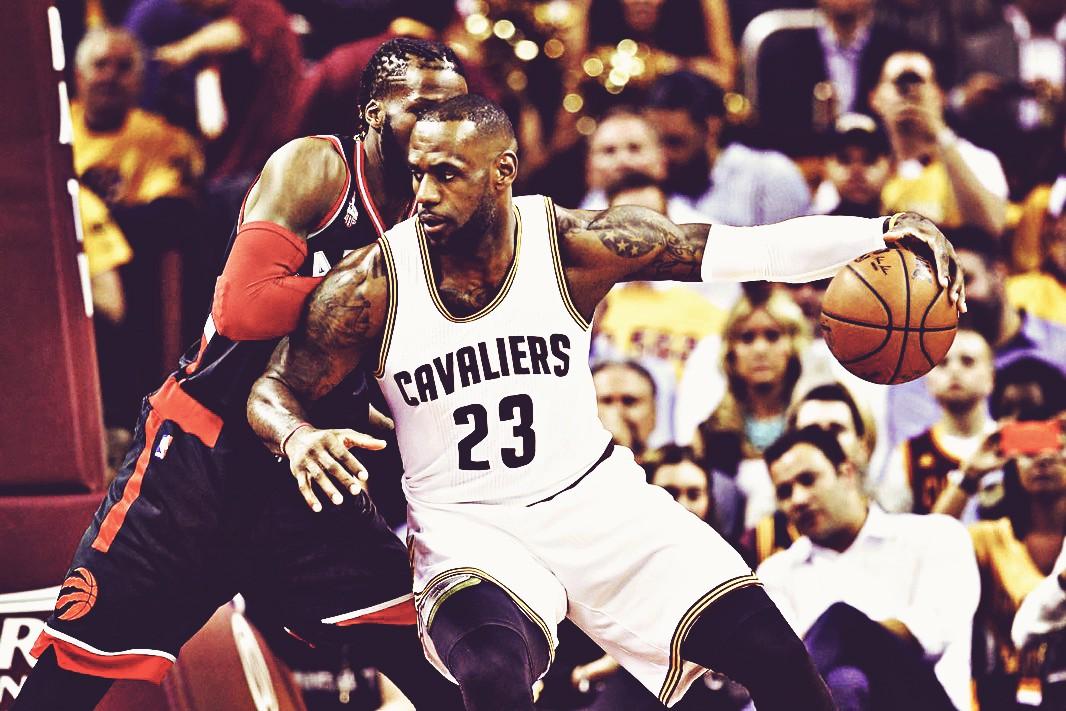Think of it as a different spin on the Warriors’ famed Lineup of Death. The Cavaliers were up 33–28 against the Raptors at the end of the first quarter in Game 1 of the Eastern Conference finals when a lineup of LeBron James, Matthew Dellavedova, Iman Shumpert, Richard Jefferson, and Channing Frye went on a 16–2 run in a little over five minutes at the start of the second, opening up the floodgates. The Cavs put four capable shooters who move the ball around LeBron and let him operate with maximum space in the paint against opposing second units. Pick your poison here: LeBron is either posting up smaller players or rolling to the rim against bigger ones. There’s no way to guard him without sending help.
LeBron’s shot chart from the Cavs’ demolition of the Raptors in Game 1 was a model of efficiency. Against a porous Toronto defense, he repeatedly took the ball to the front of the rim and scored at will, notching 24 points on 11-for-13 shooting, with only one of those shots coming outside of the paint. James has always been bigger, stronger, and quicker than his defenders, and now, under Tyronn Lue, the Cavs have been using LeBron as a traditional big man more than ever before. The gains are self-evident.
With his jumper abandoning him (hitting less than 31 percent from 3) this season, LeBron has been taking 50 percent of his shots within 0–3 feet of the rim in this season’s playoffs — a huge increase from his career postseason average of 34 percent prior to this season. There’s a lot more room to operate in the paint playing with Channing Frye and Kevin Love as opposed to Timofey Mozgov and Tristan Thompson. The improved spacing has allowed James to inhabit a new place on the court, closer to the basket, while avoiding old, ineffective stomping grounds. He’s taking less than 8 percent of his shots in the long-2 gray zone of 16–23 feet, a huge decline from his 20.8-percent career average. That’s one of the main reasons his field goal percentage has jumped more than 10 percentage points from last postseason to this.
Instead of carrying an injury-ravaged supporting cast to the NBA Finals, LeBron is playing with a locked-and-loaded team overflowing with shot-creators and shooters. The two-man combination of Frye and LeBron has been absurdly dominant — the duo had a net rating of 32.9 in 158 minutes in the regular season — and forms the core of the Lineup of Death facsimile that has a net rating of 49 in 43 minutes in the playoffs.
With room to breathe, LeBron is settling into the player he was always supposed to become with age. It’s a transition he was going to have to make at some point. At 31 and with nearly 1,200 NBA games under his belt, he can’t consistently summon the otherworldly athleticism he had at his physical peak. Rationing his energy and playing a game predicated on strength rather than speed will become the new normal. While he has always fancied himself as a point forward creating seams from the perimeter, he’s really at his best in the inverse, operating as a power point by dominating the area around the rim and leaving the jump shooting to the specialists. Great players always have to keep changing and adapting their game, and the latest iteration of LeBron could be the most difficult to stop yet.
This piece originally appeared on the Ringer Facebook page on May 19, 2016.


